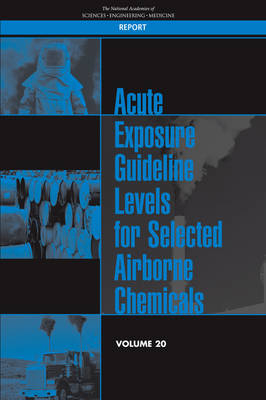
Acute Exposure Guideline Levels for Selected Airborne Chemicals
Volume 20
Seiten
2016
National Academies Press (Verlag)
978-0-309-44915-1 (ISBN)
National Academies Press (Verlag)
978-0-309-44915-1 (ISBN)
Extremely hazardous substances can be released accidentally as a result of chemical spills, industrial explosions, fires, or accidents involving railroad cars and trucks transporting EHSs. Workers and residents in communities surrounding industrial facilities where these substances are manufactured, used, or stored and in communities along the nation's railways and highways are potentially at risk of being exposed to airborne EHSs during accidental releases or intentional releases by terrorists. Pursuant to the Superfund Amendments and Reauthorization Act of 1986, the U.S. Environmental Protection Agency (EPA) has identified approximately 400 EHSs on the basis of acute lethality data in rodents.
Acute Exposure Guideline Levels for Selected Airborne Chemicals, Volume 20 reviews and updates the technical support document on acute exposure guideline levels (AEGLs) for selected chloroformates. This update focuses on establishing AEGL-3 values for n-propyl chloroformate and isopropyl chloroformate, but will also consider whether any new data are available that would affect the proposed values for the other 10 chloroformates.
AEGLs represent threshold exposure limits (exposure levels below which adverse health effects are not likely to occur) for the general public and are applicable to emergency exposures ranging from 10 minutes (min) to 8 h. Three levels - AEGL-1, AEGL-2, and AEGL-3 - are developed for each of five exposure periods (10 min, 30 min, 1 h, 4 h, and 8 h) and are distinguished by varying degrees of severity of toxic effects. This report will inform planning, response, and prevention in the community, the workplace, transportation, the military, and the remediation of Superfund sites.
Table of Contents
Front Matter
Summary
1 Introduction
2 Chloroformates Acute Exposure Guideline Levels
Appendix A Biographical Information Committee on Acute Exposure Guidelines for Chloroformates
Appendix B Benchmark Concentration Calculations for Selected Chloroformates
Appendix C Derivation of AEGL Values for Selected Chloroformates
Appendix D Acute Exposure Guideline Levels for Selected Chloroformates
Appendix E Category Plots for Selected Chloroformates
Acute Exposure Guideline Levels for Selected Airborne Chemicals, Volume 20 reviews and updates the technical support document on acute exposure guideline levels (AEGLs) for selected chloroformates. This update focuses on establishing AEGL-3 values for n-propyl chloroformate and isopropyl chloroformate, but will also consider whether any new data are available that would affect the proposed values for the other 10 chloroformates.
AEGLs represent threshold exposure limits (exposure levels below which adverse health effects are not likely to occur) for the general public and are applicable to emergency exposures ranging from 10 minutes (min) to 8 h. Three levels - AEGL-1, AEGL-2, and AEGL-3 - are developed for each of five exposure periods (10 min, 30 min, 1 h, 4 h, and 8 h) and are distinguished by varying degrees of severity of toxic effects. This report will inform planning, response, and prevention in the community, the workplace, transportation, the military, and the remediation of Superfund sites.
Table of Contents
Front Matter
Summary
1 Introduction
2 Chloroformates Acute Exposure Guideline Levels
Appendix A Biographical Information Committee on Acute Exposure Guidelines for Chloroformates
Appendix B Benchmark Concentration Calculations for Selected Chloroformates
Appendix C Derivation of AEGL Values for Selected Chloroformates
Appendix D Acute Exposure Guideline Levels for Selected Chloroformates
Appendix E Category Plots for Selected Chloroformates
1 Front Matter; 2 Summary; 3 1 Introduction; 4 2 Chloroformates Acute Exposure Guideline Levels; 5 Appendix A Biographical Information Committee on Acute Exposure Guidelines for Chloroformates; 6 Appendix B Benchmark Concentration Calculations for Selected Chloroformates; 7 Appendix C Derivation of AEGL Values for Selected Chloroformates; 8 Appendix D Acute Exposure Guideline Levels for Selected Chloroformates; 9 Appendix E Category Plots for Selected Chloroformates
| Erscheinungsdatum | 29.10.2016 |
|---|---|
| Verlagsort | Washington |
| Sprache | englisch |
| Maße | 152 x 229 mm |
| Themenwelt | Naturwissenschaften ► Biologie ► Ökologie / Naturschutz |
| ISBN-10 | 0-309-44915-4 / 0309449154 |
| ISBN-13 | 978-0-309-44915-1 / 9780309449151 |
| Zustand | Neuware |
| Haben Sie eine Frage zum Produkt? |
Mehr entdecken
aus dem Bereich
aus dem Bereich
Lehrbuch zu Grundlagen, Technologie und Praxis
Buch | Hardcover (2022)
Hanser (Verlag)
34,99 €


